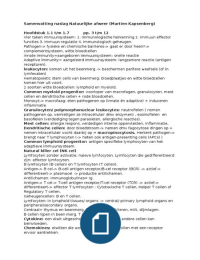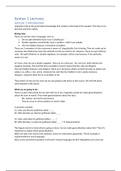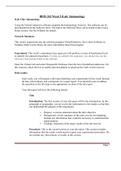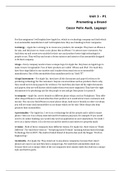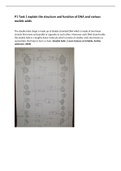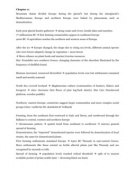Consumer and economic psychology
Lecture notes
Week 1 - Introduction
● Segmentation: ways of differentiating between groups and people
○ Geographical - low specificity, low cost, easier data access
○ Demographic - low specificity, low cost, earlier data access
○ Behavioral - high specificity, higher cost, more difficult data access
○ Psychometric - high specificity, higher cost, more difficult data access
● Consumer and economic psychology is about the interaction between people, goods
and services, and the economy
○ Consumer psychology is about the interaction between products and
people (e.g. product adoption, impact of products on people, product use)
○ Economic psychology promotes and discusses research and policy making
on the interface of psychology and economicts
■ Interaction between people and the economy (e.g. decision making
and how the economy impacts people and the other way around)
Week 2 (1) - The prosocial consumer
● Prosocial behavior is behavior that benefits other people or society as a whole.
Prosocial consumer behavior refers to purchase behavior that benefits others or
society as a whole.
○ Examples:
■ Cause-related marketing (buying x is contributing to y)
■ Charitable giving
■ Consumer activism (boycotting brands)
■ Sustainable purchasing/consumption
■ Volunteerism
■ Ethical purchasing behavior and consumption
○ What is in it for the consumer?: nothing -from a pure altruistic perspective- ->
people have motives to behave prosocially
● Indirect benefits of giving: reputation concerns
○ Reputation for cooperation: you need willingness to confer benefits onto
others, and ability to confer benefits onto others
■ In order to reach this reputation we use prosocial behavior:
altruistic/cooperative actions and costly signaling (engaging in actions
that are costly to you but benefit others in the long run)
○ Study (money allocation): when people can publicly engage in prosocial
behavior they will do so more quickly than in anonymous situations
○ Engaging in visible prosocial behavior enhances one’s reputation
● When we behave prosocially we get a warm glow: experience of joy after giving
● Attitude-behavior gap: there is a gap between people’s attitudes and prosocial
behavior
○ Possible explanations:
■ Need to belong: leads us to behave in any way that is acceptable to
the group, even when the social norm is not very strong
, ● Example: pluralistic ignorance in climate change - need to
belong can be detrimental for some types of prosocial behavior
■ Need to feel good about ourselves: people want to maintain a
positive self-concept and maximize material self-interest
● These can be aligned by:
○ Moral disengagement: people let themselves off the
hook (e.g. through dehumanization (statistical lives),
euphemistic labelling (victims are “collateral damage”)
and diffusion of responsibility)
○ Selective attention (willful ignorance): the decision to
avoid becoming informed about something, in order to
avoid having to make painful decisions that such
information might prompt
■ The people who care most about an issue were
least likely or willing to request information
about that issue: those who care will feel the
most negative emotions / responsibility
○ Do-gooder derogation: moral do-gooders elicit
downward social comparisons and challenge
observers’ moral self-concept, which triggers defensive
processing (discrediting those who do the right thing
helps restore the threatened moral self-concept)
→ Counters prosocial behavior
→ Defensive responses imply that people care
Week 2 (2) - Social inequality
● Social inequality - social stratification: early thoughts
○ Differences in ownership of the means of production: owners vs. employees
(Marx)
■ Working class vs. owners of means and productions -> social classes
-> class struggle
○ Several sources of inequality: economic situation, social status, and power
(Weber)
● Social inequality has different dimensions and these have different consequences for
preferences, such as the economic and educational dimension
○ Terms and indicators: social class, occupation, income/wealth, education, and
socioeconomic status
○ Education is a dimension of inequality in its own right and is more related to
social status – gives access to occupations with higher incomes
○ Income: people can only spend what they have
■ Research about decision making when people have few resources:
poor decisions, focus on short-term, lower performance on cognitive
tasks - but focus on short term is often functional and adaptive
■ Rational actor model: people make decisions in their own best
interest, but inequality is also a social divide:
● People form groups based on SES
● Segregation
● Groups have values and norms
Lecture notes
Week 1 - Introduction
● Segmentation: ways of differentiating between groups and people
○ Geographical - low specificity, low cost, easier data access
○ Demographic - low specificity, low cost, earlier data access
○ Behavioral - high specificity, higher cost, more difficult data access
○ Psychometric - high specificity, higher cost, more difficult data access
● Consumer and economic psychology is about the interaction between people, goods
and services, and the economy
○ Consumer psychology is about the interaction between products and
people (e.g. product adoption, impact of products on people, product use)
○ Economic psychology promotes and discusses research and policy making
on the interface of psychology and economicts
■ Interaction between people and the economy (e.g. decision making
and how the economy impacts people and the other way around)
Week 2 (1) - The prosocial consumer
● Prosocial behavior is behavior that benefits other people or society as a whole.
Prosocial consumer behavior refers to purchase behavior that benefits others or
society as a whole.
○ Examples:
■ Cause-related marketing (buying x is contributing to y)
■ Charitable giving
■ Consumer activism (boycotting brands)
■ Sustainable purchasing/consumption
■ Volunteerism
■ Ethical purchasing behavior and consumption
○ What is in it for the consumer?: nothing -from a pure altruistic perspective- ->
people have motives to behave prosocially
● Indirect benefits of giving: reputation concerns
○ Reputation for cooperation: you need willingness to confer benefits onto
others, and ability to confer benefits onto others
■ In order to reach this reputation we use prosocial behavior:
altruistic/cooperative actions and costly signaling (engaging in actions
that are costly to you but benefit others in the long run)
○ Study (money allocation): when people can publicly engage in prosocial
behavior they will do so more quickly than in anonymous situations
○ Engaging in visible prosocial behavior enhances one’s reputation
● When we behave prosocially we get a warm glow: experience of joy after giving
● Attitude-behavior gap: there is a gap between people’s attitudes and prosocial
behavior
○ Possible explanations:
■ Need to belong: leads us to behave in any way that is acceptable to
the group, even when the social norm is not very strong
, ● Example: pluralistic ignorance in climate change - need to
belong can be detrimental for some types of prosocial behavior
■ Need to feel good about ourselves: people want to maintain a
positive self-concept and maximize material self-interest
● These can be aligned by:
○ Moral disengagement: people let themselves off the
hook (e.g. through dehumanization (statistical lives),
euphemistic labelling (victims are “collateral damage”)
and diffusion of responsibility)
○ Selective attention (willful ignorance): the decision to
avoid becoming informed about something, in order to
avoid having to make painful decisions that such
information might prompt
■ The people who care most about an issue were
least likely or willing to request information
about that issue: those who care will feel the
most negative emotions / responsibility
○ Do-gooder derogation: moral do-gooders elicit
downward social comparisons and challenge
observers’ moral self-concept, which triggers defensive
processing (discrediting those who do the right thing
helps restore the threatened moral self-concept)
→ Counters prosocial behavior
→ Defensive responses imply that people care
Week 2 (2) - Social inequality
● Social inequality - social stratification: early thoughts
○ Differences in ownership of the means of production: owners vs. employees
(Marx)
■ Working class vs. owners of means and productions -> social classes
-> class struggle
○ Several sources of inequality: economic situation, social status, and power
(Weber)
● Social inequality has different dimensions and these have different consequences for
preferences, such as the economic and educational dimension
○ Terms and indicators: social class, occupation, income/wealth, education, and
socioeconomic status
○ Education is a dimension of inequality in its own right and is more related to
social status – gives access to occupations with higher incomes
○ Income: people can only spend what they have
■ Research about decision making when people have few resources:
poor decisions, focus on short-term, lower performance on cognitive
tasks - but focus on short term is often functional and adaptive
■ Rational actor model: people make decisions in their own best
interest, but inequality is also a social divide:
● People form groups based on SES
● Segregation
● Groups have values and norms

